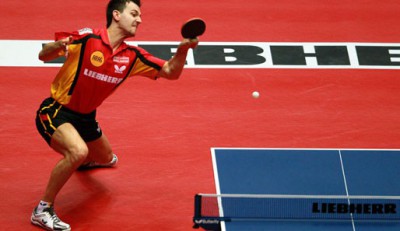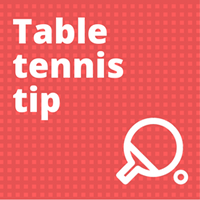
Most professional table tennis players love to attack with their forehand from all areas of the table, including the backhand corner. They have the ability to step around the backhand corner, attack with their forehand and then effortlessly recover to play a forehand attack from the opposite corner. They make it look so easy.
For a lot of amateur table tennis players, it’s a different story. They find it hard to get in the right position to attack with their forehand from the backhand corner. And even if they do make the attack, they often find it difficult to recover for the next ball.
So what are the professionals doing which the rest of us can learn from?
Footwork and balance
The most common mistake players make when attempting to play a forehand attack from the backhand corner is not moving enough.
They will move to the backhand corner a little bit, but then lean away from the ball to try and make the space to play the forehand attack. You should avoid doing this. If you lean away from the ball whilst attacking, your attack will usually be much weaker. You will also be off-balance, which makes it much harder to recover to play the next ball.
Instead of leaning, you should move feet further into the backhand corner. The wider the ball, the more you will need to move. If the ball is very wide, you will need to move your feet and body completely off the table.
The reason you need move so far into the backhand corner is so you are completely balanced when you attack. If you are balanced, you can play a powerful attack and recover quicker for the next ball.
It may seem risky moving so far off the table to play a forehand attack because you’re leaving the rest of the table exposed for a block or counter attack. But actually it is much less risky than leaning. This is because your attack will be stronger, so there is less chance it will be returned. And even if the ball is returned, you will recover quicker if you off the table and balanced, compared to being closer to the table and off-balance.
Here’s a great video from PingSkills, which goes into a bit more detail about where to position your feet and body.
Placement
A second common mistake players make when attacking with their forehand from the backhand corner is always attacking to the same position. I have played opponents who move beautifully in the backhand corner. They play a strong attack with their forehand. But they always play to the same position (usually cross-court). This makes their attack much easier to block. If I know where they are going to attack, I can get into position quicker and play a strong block or counterattack.
So don’t be predictable. You should attack crosscourt, down the line and to your opponent’s playing elbow (their crossover point). If you mix up where you attack, it will be much harder for your opponent to anticipate where the ball is going and they will return less balls.
Recovery
The third common mistake players make is not expecting the ball to come back. They move to the backhand corner, play a great forehand attack and watch the ball as it whizzes away for a winner. Except it’s not a winner! Their opponent blocks the ball back and all of a sudden they are desperately scrambling to reach the next ball.
Always expect the ball to be returned. Be prepared for your opponent to block the ball back to any position on the table. In particular, you need to be ready to move quickly across the table to cover the open space in the forehand corner. It’s not good enough watch and admire your own attack. Get ready for the next ball. If the ball doesn’t come back, well that’s a bonus. But you would have been ready anyway, right?
Tactics
Is it always a good idea to attack with your forehand from the backhand corner? This really depends on your strengths and weaknesses and the strengths and weaknesses of your opponent.
Firstly, how strong is your forehand attack compared to your backhand attack? If you have a much stronger forehand attack, then it makes sense to try and attack with your forehand from all areas of the table. The more you can use your strength the more success you will have.
If you have an equally strong forehand and backhand attack (well done you), then you have more options. You can attack with your backhand or forehand in the backhand corner. But you should vary it. Sometimes attack with your backhand. Sometimes attack with your forehand. If your opponent doesn’t know what to expect, they will find it much harder to return your attacks.
If you have a much stronger backhand attack, then it doesn’t make that much sense to step around the table and use your weaker shot. However, this doesn’t mean you should just forget all about it. In the long term, you will add more variety to your game if you can play a forehand attack from the backhand corner. So focus on practicing this until you can do it well, then try using in competitive matches.
The second thing to consider is how good your opponent is at blocking. If your opponent is good at blocking, the shot becomes a bit more risky. Your attack needs to be very good and recovery quick, otherwise they may make you look foolish by blocking the ball back for a clean winner on the open side of the table. If your opponent is no good at blocking, then attacking with your forehand from the backhand corner isn’t really risky at all. Just make sure you make enough space and keep balanced and you should win lots of points.
Thirdly, how quick is your footwork? If you are young, fit and healthy, you should have no problem covering both the backhand and forehand corner with your forehand. As you get older, it definitely becomes harder to cover the same space. So you need to know your own limits. If you think you have the athleticism to cover the space, go for it. If you feel it is physically beyond you, then probably best to play backhand attacks in the backhand corner.
Training drills
There are two very simple drills you can do to improve playing forehand attacks from the backhand corner.
The first drill is simply playing one backhand and then one forehand from the backhand corner (watch the PingSkills video above to see how this is done).
The second drill is the famous ‘falkenberg’. In this drill you play one backhand and then one forehand from the backhand corner and then a forehand from the forehand corner. Here’s a video demonstration:
In summary, to play great forehand attacks from the backhand corner, you need to:
- Move your feet and body so you have enough space to play your forehand attack
- Keep balanced when you attack
- Attack to different positions on the table
- Always expect the ball to be returned
Let me know how you get on!


